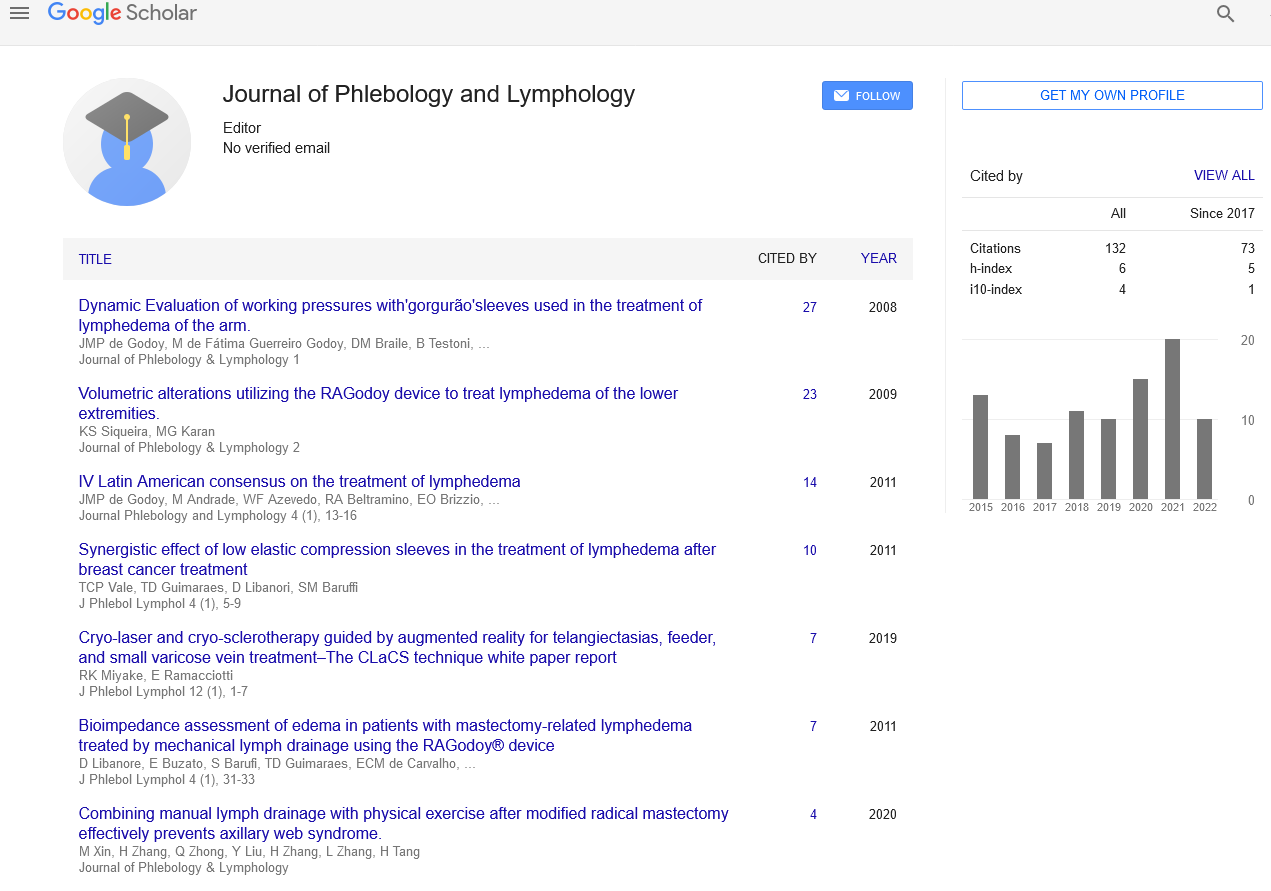Advancements in phlebology: pioneering insights into venous health
Received: 05-Jan-2023, Manuscript No. puljpl-23-6474; Editor assigned: 08-Jan-2023, Pre QC No. puljpl-23-6474 (PQ); Accepted Date: Jan 27, 2023; Reviewed: 23-Jan-2023 QC No. puljpl-23-6474 (Q); Revised: 26-Jan-2023, Manuscript No. puljpl-23-6474 (R); Published: 28-Dec-2023, DOI: 10.3752/puljpl.2023.16(1).01-02
Citation: Jenner D. Advancements in phlebology: Pioneering insights into venous health. J Phlebol Lymphology. 2023; 16(1):1-3.
This open-access article is distributed under the terms of the Creative Commons Attribution Non-Commercial License (CC BY-NC) (http://creativecommons.org/licenses/by-nc/4.0/), which permits reuse, distribution and reproduction of the article, provided that the original work is properly cited and the reuse is restricted to noncommercial purposes. For commercial reuse, contact reprints@pulsus.com
Abstract
The research and treatment of venous problems are the focus of the specialized field of medicine known as phlebology, which has advanced significantly in recent years. Phlebologists have worked to innovate the diagnosis, management, and treatment of problems like varicose veins, deep vein thrombosis, and chronic venous The research and treatment of venous problems are the focus of the specialized field of medicine known as phlebology, which has advanced significantly in recent years. Phlebologists have worked to innovate the diagnosis, management, and treatment of problems like varicose veins, deep vein thrombosis, and chronic venous
Key Words
Varicose veins, Venous stasis, Venous disorders
Introduction
Phlebology, the specialized branch of medicine dedicated to the study and treatment of venous disorders, has made remarkable strides in recent years. With a focus on understanding the complexities of venous health, phlebologists have sought to revolutionize the diagnosis, management, and treatment of conditions such as varicose veins, deep vein thrombosis, and chronic venous insufficiency. This commentary article aims to disseminate knowledge and highlight the groundbreaking advancements in the field of phlebology, emphasizing the interdisciplinary collaboration, technological innovations, and novel treatment modalities that have transformed patient care.
Venous health, often overshadowed by its arterial counterpart, has long been a neglected field in medical research. However, the recognition of the significant impact of venous disorders on patient quality of life and the growing awareness of their associated complications have propelled phlebology to the forefront of medical advancements.
The etiology of venous disorders is multifactorial, involving genetic predispositions, lifestyle factors, and age-related changes. Conditions such as varicose veins, characterized by enlarged and tortuous veins, can cause discomfort, pain, and cosmetic concerns. Deep vein thrombosis, a potentially life-threatening condition, occurs when blood clots form in the deep veins, often leading to pulmonary embolism. Chronic venous insufficiency, marked by impaired blood flow, can result in skin changes, ulcers, and impaired mobility.
Phlebology thrives on interdisciplinary collaboration, pooling the expertise of vascular surgeons, interventional radiologists, dermatologists, and other medical professionals. This collaboration has been instrumental in uncovering new insights into venous health. By integrating advanced imaging techniques, such as duplex ultrasonography, computed tomography, and magnetic resonance imaging, phlebologists can precisely visualize venous anatomy and pathology. They can identify incompetent veins, detect blood clots, and map out venous reflux, leading to accurate diagnoses and personalized treatment plans.
Additionally, genetic studies have shed light on hereditary factors that predispose individuals to venous disorders. The identification of specific genes and genetic variants has paved the way for personalized medicine approaches, allowing for targeted interventions and risk stratification.
Technological advancements have revolutionized the diagnostic landscape in phlebology, providing non-invasive and accurate tools for assessing venous health. One such innovation is the advent of minimally invasive endovenous techniques. Endovenous thermal ablation procedures, such as radiofrequency ablation and endovenous laser therapy, have replaced traditional surgical vein stripping, offering excellent clinical outcomes with minimal downtime. Ultrasound-guided foam sclerotherapy has also emerged as an effective treatment modality, allowing for the closure of diseased veins by injecting a foam solution. Furthermore, novel imaging modalities, such as intravascular ultrasound and optical coherence tomography, enable detailed visualization of the venous system's microarchitecture. These technologies provide valuable information on venous wall morphology, thrombus composition, and endothelial function, aiding in the early detection and characterization of venous diseases. The field of phlebology has witnessed the emergence of innovative treatment modalities that aim to improve patient outcomes and minimize invasiveness
One notable advancement is the development of endovascular interventions. These minimally invasive procedures, including venous stenting and thrombolysis, have transformed the management of deep vein thrombosis and chronic venous obstruction. They offer improved outcomes, reduced hospital stays, and enhanced quality of life for patients. In addition, the rise of cosmetic phlebology has led to the development of interventions that target the aesthetic aspects of venous disorders.
Conclusion
Phlebology has made significant strides in advancing the understanding and management of venous disorders. Through interdisciplinary collaboration, technological innovations, and novel treatment modalities, phlebologists have transformed the field, offering patients improved diagnostic accuracy, minimally invasive interventions, and enhanced outcomes. These advancements have not only improved patient care but also elevated the status of venous health within the broader medical community. As phlebology continues to evolve, it promises to unravel further insights into venous health, paving the way for innovative strategies in diagnosis, treatment, and prevention of venous disorders.





